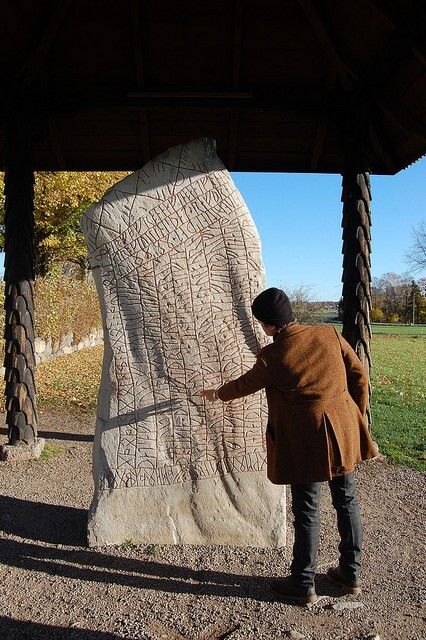
UNIVERSITY OF GOTHENBURG—The Rök Runestone, erected in the late 800s in the Swedish province of Östergötland, is the world’s most well-known runestone. Its long inscription has seemed impossible to understand, despite the fact that it is relatively easy to read. A new interpretation of the inscription has now been presented – an interpretation that breaks completely with a century-old interpretative tradition. What has previously been understood as references to heroic feats, kings and wars in fact seems to refer to the monument itself.
“The inscription on the Rök Runestone is not as hard to understand as previously thought,” says Per Holmberg, associate professor of Scandinavian languages at the University of Gothenburg. “The riddles on the front of the stone have to do with the daylight that we need to be able to read the runes, and on the back are riddles that probably have to do with the carving of the runes and the runic alphabet, the so called futhark.”
Previous research has treated the Rök Runestone as a unique runestone that gives accounts of long forgotten acts of heroism. This understanding has sparked speculations about how Varin, who made the inscriptions on the stone, was related to Gothic kings. In his research, Holmberg shows that the Rök Runestone can be understood as more similar to other runestones from the Viking Age. In most cases, runestone inscriptions say something about themselves.
“Already 10 years ago, the linguist Professor Bo Ralph proposed that the old idea that the Rök Runestone mentions the Gothic emperor Theodoric is based on a minor reading error and a major portion of nationalistic wishful thinking. What has been missing is an interpretation of the whole inscription that is unaffected by such fantasies.”
____________________________________________
Per Holmberg, researcher at University of Gothenburg with the Rök Runestone. Credit: University of Gothenburg
___________________________________________
Holmberg’s study is based on social semiotics, a theory about how language is a potential for realizing meaning in different types of texts and contexts.
“Without a modern text theory, it would not have been possible to explore which meanings are the most important for runestones. Nor would it have been possible to test the hypothesis that the Rök Runestone expresses similar meanings as other runestones, despite the fact that its inscription is unusually long.”
One feature of the Rök Runestone that researchers have struggled with is that its inscription begins by listing in numerical order what it wants the reader to guess (‘Secondly, say who…’), but then seems to skip all the way to ‘twelfth, …’. Previous research has assumed there was an oral version of the message that included the missing nine riddles. Holmberg reaches a surprising conclusion:
“If you let the inscription lead you step by step around the stone, the twelfth actually appears as the twelfth thing the reader is supposed to consider. It’s not the inscription that skips over something. It’s the researchers that have taken a wrong way through the inscription, in order to make it be about heroic deeds.”
For over a century, the traditional interpretation has contributed to our understanding of the Viking Age. With the new interpretation, the Rök Runestone does not carry a message of honour and vengeance. Instead the message concerns how the technology of writing gives us an opportunity to commemorate those who have passed away.
Source: University of Gothenburg press release
__________________________________________________________
The study is presented in the article, Answers to the Rök runestone riddles: A study of meaning-making and spatiality, Futhark. International Journal of Runic Studies 6 (2015, publ. 2016). 65-106. The article is also available at: http://urn.kb.se/res?urnolve=urn:nbn:se:uu:diva-278891
__________________________________________________________

______________________________________________
Travel and learn with Far Horizons.
____________________________________________
This richly illustrated issue includes the following stories: Recent findings shedding new light on the whereabouts of the remains of Philip of Macedon, father of Alexander the Great; how an archaeologist-sculptor is bringing bones of the dead back to life; archaeologists uncovering town life at the dawn of civilization; an exclusive interview with internationally acclaimed archaeologist James M. Adovasio about what makes the Meadowcroft Rockshelter prominent in the ongoing search for the first Americans; what archaeologists are finding at the site of the ancient city of Gath, the home town of the biblical Philistine giant, Goliath; and how scientists are redrawing the picture of human evolution in Europe. Find it on Amazon.com.






